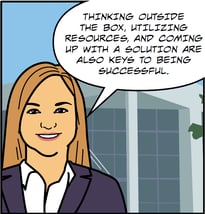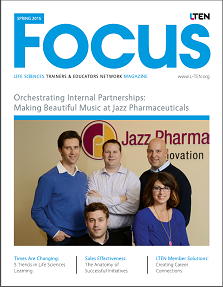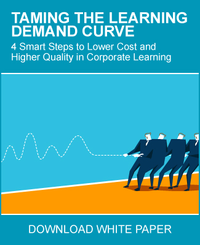 Yeah, yeah, I know. Yet another “here’s what to expect in the New Year” post. The only thing more certain than hangovers and “this year I get in shape!” commitments is people coming out the woodwork to prognosticate the future. And tempting as it was to remain in the woodwork this year, after reading a few dozen “learning trends” posts, I felt there was something missing. There were predictions a-plenty on what technology we would love, on the needs of the Millennials, and the learning modalities du jour. But it seems like nobody is addressing the real question:
Yeah, yeah, I know. Yet another “here’s what to expect in the New Year” post. The only thing more certain than hangovers and “this year I get in shape!” commitments is people coming out the woodwork to prognosticate the future. And tempting as it was to remain in the woodwork this year, after reading a few dozen “learning trends” posts, I felt there was something missing. There were predictions a-plenty on what technology we would love, on the needs of the Millennials, and the learning modalities du jour. But it seems like nobody is addressing the real question:
How will learning align with and drive the business?
So pardon me for poking my head from the woodpile and sharing the five key trends for running learning as a business.
- Successful Learning Organizations will have a seat at the table. It seems absurd that Learning Organizations are often not mainstreamed into strategic planning. They are responsible for preparing the workforce to fulfill the company’s business goals; why would they be an afterthought in the planning process? In many organizations, Learning has that seat at the table, and is fully integrated with strategic planning. That means the entire Learning Organization is oriented around achieving the company’s business goals. I’m currently on a judging panel for a learning industry award. In reviewing the applications, it’s pretty easy to see where Learning has a seat at the table and where they don’t. When they don’t, answers to questions about strategic alignment are vague, metrics are unclear, and success tends to be measured in “learning” terms, like number of people trained and good test scores. But when Learning has a seat at the table, Learning goals and business goals are basically the same, metrics are specific, and success is measured on driving those metrics.
- Learning Innovation requires thinking Like a CEO. Innovation means change, and change costs money, disrupts the status quo, and generally makes people edgy. Too many learning leaders try to drive change because it’s “a good idea,” or because “people will learn better.” Your CEO wants innovation to drive positive change in business metrics. So the rationale for innovation needs to demonstrate things that matter to the business: competitive advantage, speed to capability, growth in revenue or market share, or reduction in cost. Feel like you can’t make that case? That’s going to make the argument a lot tougher.
- The Learning Supply Chain is just as important as any other supply chain in the business. Supply chain is about how we acquire the goods and services we need to provide the goods and services we produce. It’s easy to identify the supply chain in manufacturing (machinery, raw materials, etc.), but we often miss it in Learning. But in truth, our supply chain is critical. What gets done internally or by vendor partners? How do we do that cost effectively? How do we scale up to meet changing needs without taking on unreasonable risk? How do we respond to unplanned or unexpected needs of the business? Without a strong supply chain in place, we may fail—or at very least, damage our costs and deadlines unnecessarily.
- New Technology adoption hinges on tactical buy-in. We have better learning technology than ever, yet we are getting far less value from it than we should. Why? Because in many cases, it has been implemented improperly, poorly leveraged, or simply never implemented at all. Successful technology implementation has many gatekeepers. Your IT team may resist a broad implementation. Your Regulatory or Legal team may see risk. Your executive team may struggle with expense or cultural issues. I can’t tell you how many times I’ve seen learning leaders throw their hands up in the air and say, “I want to implement this, but I can’t get IT/Legal/Regulatory/etc. on board.” You’ll need great content to get that technology to work, but you’ll never get that far if you can’t address the tactical challenges of getting it implemented.
- Constant Whitewater is here to stay. Once upon a time, organizations had “evergreen” courses that they could run for years without significant update. In most industries today, however, change is a constant, and Learning Organizations need to be more flexible than ever. Whether it’s new products, new competitors, disruptive technology, marketplace shifts, or a changing regulatory environment, many businesses are in a state of constant change and Learning Organizations need to be prepared to change with them. That means re-evaluating the resourcing, the processes, and the priorities of your Learning Organization. Why should the business wait for the Learning Organization to catch up?
Want more information of running the Learning Organization like a business? Read our recent article in Training Industry Magazine, “Be the CEO of Your Learning Organization.”

Rich Mesch is Vice President, Customer Engagement at Performance Development Group. A frequent contributor to industry events and publications, his most recent article was Be the CEO of Your Learning Organization for Training Industry's online magazine.










 Robert Baker
Robert Baker Kim Robbins
Kim Robbins Jamie Rondeau
Jamie Rondeau Is it difficult to get new behaviors from an experienced sales team? The tenured sales force responsible for Genzyme’s Multiple Sclerosis product (AUBAGIO®) had seen it all. The Genzyme learning team knew they needed to find an engaging, time-effective way of spreading best practices across the sales team to drive continued performance. Learn how Genzyme used both cutting-edge and well established methods to create a blended approach that feels fresh and new.
Is it difficult to get new behaviors from an experienced sales team? The tenured sales force responsible for Genzyme’s Multiple Sclerosis product (AUBAGIO®) had seen it all. The Genzyme learning team knew they needed to find an engaging, time-effective way of spreading best practices across the sales team to drive continued performance. Learn how Genzyme used both cutting-edge and well established methods to create a blended approach that feels fresh and new. David Barker
David Barker  Marcus Hswe
Marcus Hswe



 AS: What we have started to see from our clients are requests for Launch Toolkits. A launch toolkit puts a step by step process in place for product launches. This gives consistency to the product launch process. You can use the Launch Toolkit to capture a history of product launches so that the process is in place for new employees to the department.
AS: What we have started to see from our clients are requests for Launch Toolkits. A launch toolkit puts a step by step process in place for product launches. This gives consistency to the product launch process. You can use the Launch Toolkit to capture a history of product launches so that the process is in place for new employees to the department.  Q: What is important to keep in mind when developing product launches?
Q: What is important to keep in mind when developing product launches?

 Ann Stott: It is beneficial to take a portfolio view, looking at all product launches over a three-year period. Not only do you create a launch plan for each product but you create an overall launch portfolio plan for all of your products. A launch portfolio plan helps to optimize your events and balances activities across all launches. It helps to maximize messages to your audiences and minimizes the time your sales representatives have out of the field. Launch portfolio optimization helps ensure adequate funding, supports a better commercial strategy, and can help get launch events to market more quickly.
Ann Stott: It is beneficial to take a portfolio view, looking at all product launches over a three-year period. Not only do you create a launch plan for each product but you create an overall launch portfolio plan for all of your products. A launch portfolio plan helps to optimize your events and balances activities across all launches. It helps to maximize messages to your audiences and minimizes the time your sales representatives have out of the field. Launch portfolio optimization helps ensure adequate funding, supports a better commercial strategy, and can help get launch events to market more quickly. Another way to combat knowledge loss is to develop a Launch University. The Launch University can be a one-day meeting or a virtual meeting. It is a time where you bring people together who have done product launches within the past three to four years. The Launch University is a venue to discuss what went well what didn’t go well and get the expertise of lessons learned from previous launches. You can pull that knowledge from employees who have moved on to other positions in the organization. Experience is the best teacher, but that information needs to be shared to make a difference!
Another way to combat knowledge loss is to develop a Launch University. The Launch University can be a one-day meeting or a virtual meeting. It is a time where you bring people together who have done product launches within the past three to four years. The Launch University is a venue to discuss what went well what didn’t go well and get the expertise of lessons learned from previous launches. You can pull that knowledge from employees who have moved on to other positions in the organization. Experience is the best teacher, but that information needs to be shared to make a difference!

